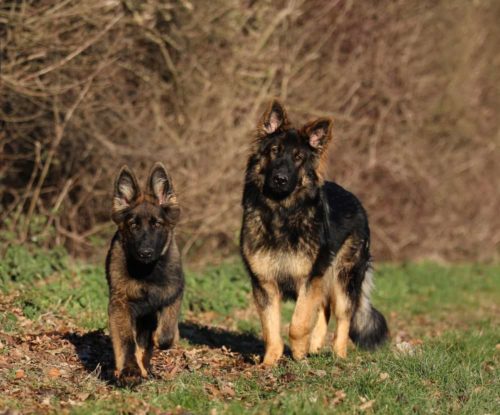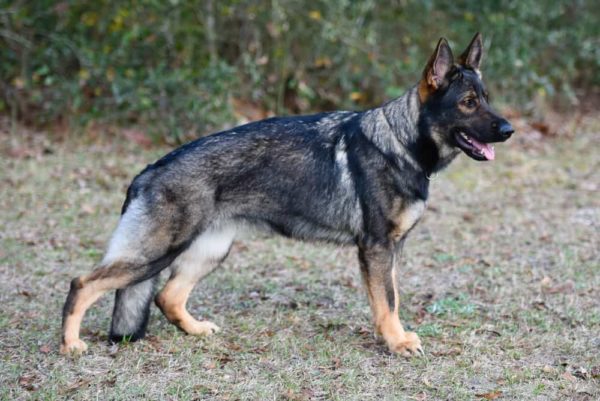Sable German Shepherd: Does Coat Color Affect Behavior and Health?
What is a sable German Shepherd?
These dogs will have different bands of color on certain parts of their fur, ranging from gray to tan, or even silver, but there will always be black tips.
Despite their unique coloring, sable German Shepherds do not differ from the breed standard in any way.
However, certain studies do claim that a dog’s color can actually impact its health and behavior.
However, there are hundreds of breeds out there, and no specific study has been done that links sable coloring to temperament changes among German Shepherds.

Sable German Shepherd: Potential Colors
Sable refers to the color pattern that wolves have. For a sable German Shepherd, this color pattern works differently. As a sable German Shepherd puppy grows, the pigmentation or color of its fur changes.
These dogs are born with tan coloring, and as they age, these colors can get lighter or darker. This change in coloring happens as the coat grows.
It can get darker – some sable German Shepherds are born with a light coat. As they grow, the coat becomes dark, especially on their backs.
These are called black sable German Shepherds.
It can get lighter – lightening of color often happens to silver sable German Shepherds. The lightening of their color happens on the sides
It develops a mahogany color – mahogany or red color happens when the coat of your sable German Shepherd either gets lighter or darker.
This can happen in a variety of ways – it can get darker to start, and then lighter, resulting in a red coat.
Once a sable German Shepherd has reached its third birthday, its colors will no longer change.
By then, you will be able to identify whether you have a black or silver sable German Shepherd.
What Are the Different Classes of German Shepherds?
The German Shepherd breed is one of the most popular breeds of dogs in the world, and thanks to its intelligence, it is also one of the most respected and recognized breeds.
GSD capabilities are wide-ranging and are loving pets that families across the globe adore.
German Shepherds are medium to large in size and have medium to long coats which are double-layered.
The top layer is coarser, it is the guard hair that protects and insulates, and the undercoat is softer and thicker.
As recognized by the World Canine Organization, here are the different classes of German Shepherds:
- Saddle coat German Shepherd
- Black German Shepherd
- Sable German Shepherd
- Panda German Shepherd
- White German Shepherd
What Does The Agouti Gene Have To Do With Sable Coloring?
The dominating factor in Sable German Shepherds is the agouti gene or “A” locus, which refers to a color and a locus.
The “A” locus here encompasses four major genes.
It is actually caused by the same DNA that contributes to its wolf-like appearance, which the original German Shepherds in Germany possessed.
Scientists believe a modifier creates the unusual red or tan fur, as genes, or alleles, affect coat colors and patterns in dogs.
Every set of genes has two copies and can be identical or different.
If the two copies are different, one typically dominates the other, and the dominant copy will show up as a physical characteristic, while the other is recessive and will not appear.
Here are some known facts about the agouti German Shepherd:
- Size – a female sable German Shepherd will grow to roughly 24 inches tall, while males grow up to 26 inches tall
- Weight – a female sable German Shepherd can weigh up to 95 pounds, while males can weigh up to 95 pounds
- Lifespan – a sable German Shepherd can live up to roughly 13 years
- Purpose and breed – sable German Shepherds are a herding breed and its original purpose was as a working dog
- Color – sable
- Temperament – loving, loyal, protective, and intelligent
The Sable Color & Pigmentation
How It Affects Other Animals
Scientists have linked two things to animal color – temperament and health.
Studies with different breeds of dogs have been conducted to determine whether color actually affects health and behavior.
Some findings include:
- Dogs with major white pigmentation like Dalmatians are more nervous as compared to other Dalmatians with less white pigmentation
- Dogs with bluish color are at a higher risk of developing neurological disorders, among other conditions
- Dogs with bluish eyes like Dalmatians are prone to becoming deaf as compared to Dals with black eyes
How It Affects Sable German Shepherds
The only reason why sable German Shepherds have their unique fur color is because of the ‘agouti’ genes.
Luckily, ‘agouti’ genes are not associated with any negative behaviors or health conditions.
In general, sable German Shepherds are just like standard German Shepherds.
They do not differ from the breed standard when it comes to their physical & mental abilities, as well as anything health related – they stay true to the breed standard.
Just like standard German Shepherds, Sable GSDs work in the police force and the military, where the sable appearance is irrelevant.
Temperament
Sable German Shepherds are working dogs, known for their patience, self-assuredness, confidence, and responsiveness to their owners.
Just like any German Shepherd, a sable German Shepherd has to be trained at an early age to control its aggressive behavior.
Sable German Shepherd Grooming Requirements
Sable German Shepherd is a heavy shedder that shed regularly as well as seasonally.
They do shed more during warmer months in order to prepare their bodies for summer, and you will need to vacuum regularly if you have a German Shepherd at home!
Bath a sable GSD as needed – too much exposure to water can dry a dog’s skin.
You should also give your canine a good brushing at least once per day, or every other day, in order to help with shedding and matting.
Nutrition
A sable German Shepherd requires a high-protein diet.
Even if it is a family dog that doesn’t work, it’s still a highly active breed with serious exercise requirements.
Hence why it needs to be fed a proper diet full of vitamins, minerals, proteins, and fats. Some German Shepherd owners even feed their canines raw meat.
Although raw meat can be great, some owners do prefer dry kibbles, or a wet diet.
If you are going to feed your sable German Shepherd with commercial dog food, be sure to choose the ones that are approved by the AAFCO.
Sable German Shepherd Training and Regular Activity
Proper socialization is very important for a growing sable German Shepherd.
It will help curtail their aggressive behavior and channel their excessive behavior into good activities.
Sable German Shepherds are intelligent and easy to train, especially if this training and socialization start at an early age.
You can give your dog stimulating activities and mental games such as tug-of-war, hide-and-seek, and fetch games.
Not only will they get their daily exercise requirements, but it will activate their minds as well.
Sensory snuffle mats are great toys to have for your German Shepherd.
You can hide their treats and kibbles in these mats, forcing your dog to use its sense of smell to find the hidden treasures!
When it comes to regular activities, this breed needs A LOT of exercises.
Take your sable dog on a run, and you can even introduce it to swimming to make their hips and legs stronger.
Be aware though that German Shepherds are not naturally great swimmers.

Common Health Issues
German Shepherds are prone to developing hip dysplasia and the sable class is no different.
Hip dysplasia is the most common orthopedic disease in medium to large-size dogs.
Unfortunately, it is a hereditary disease and there is no test to check for it due to its complex nature.
In humans, it’s comparable to arthritis. Swimming can actually help make their legs stronger and less susceptible to dysplasia.
Other conditions to watch out for in your sable German Shepherd include:
- Epilepsy
- Digestive difficulty
- Corneal inflammation
- Bloating
- Eczema
- Flea allergies
- Pancreatic insufficiency
- Perianal fistulas
- Willebrand’s disease
Buy A Sable German Shepherd From A Responsible Breeder
If you are wanting to buy a sable German Shepherd puppy, remember that you won’t know the real color of your German Shepherd until it turns 3 years old.
A sable German Shepherd pup will most likely be tan, and any breeder should be able to explain the parent dogs’ genetic makeup in order to ‘guesstimate’ the puppy’s potential colors in the future.
Before buying a pup, ask your breeder certain questions such as the history of the puppy, its parents, and its current condition.
Ask for a referral for a vet that you can trust, and ask for a tour of the breeder’s facilities to ensure that you are dealing with a legitimate and responsible breeder.
FAQ:
1. What is a sable German Shepherd?
Answer: A sable German Shepherd is a type of German Shepherd that has distinctive bands of color ranging from gray to tan, or even silver, with black tips. These dogs do not differ from the breed standard in any other way.
2. Can the color of a sable German Shepherd impact its health and behavior?
Answer: There have been studies conducted to determine whether a dog’s color can affect its health and behavior, but no specific study has been done that links sable coloring to temperament changes among German Shepherds.
3. What are the different colors of sable German Shepherds?
Answer: Sable German Shepherds can have gray, tan, silver, or even mahogany-colored fur. Their coloring can change as they age, with some sable German Shepherds becoming black sable or even silver sable as they mature.
4. What are the different classes of German Shepherds?
Answer: According to the World Canine Organization, there are five different recognized classes of German Shepherds. These are saddle coat, black, sable, panda, and white.
5. Do sable German Shepherds have any specific health issues?
Answer: Like all German Shepherds, sable German Shepherds can be prone to developing hip dysplasia, as well as other conditions such as epilepsy, digestive difficulties, and eczema. It’s important to be aware of the potential health issues for any breed of dog and to consult with a vet if you have any concerns.































